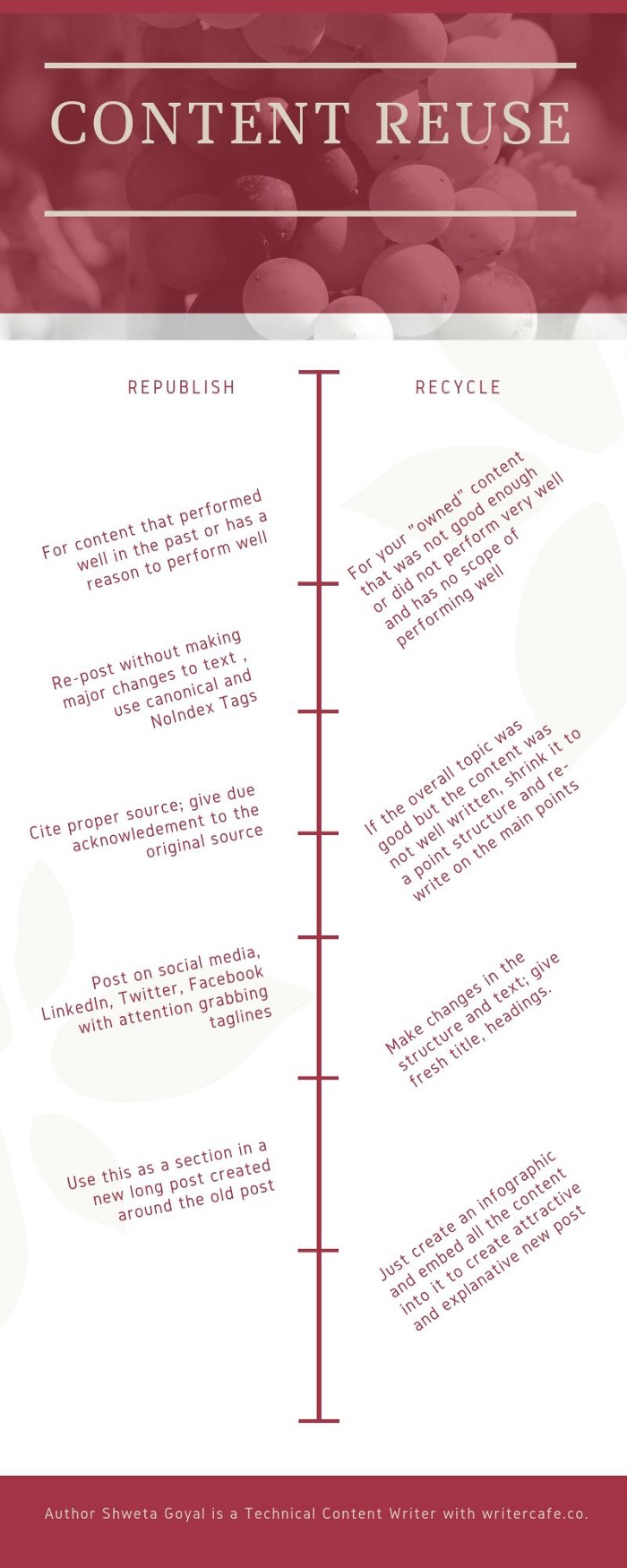
Tips on Content Reuse & Republish
Content marketers frequently realise the need for reusing their old content. But, the question is, “how to reuse the content in the best possible manner and how to select the techniques based on content quality?”.
Simple Strategies to Reuse and Repurpose Your Content
Every good piece of writing is a precious asset for the creator. With time, your old content stops adding to content marketing even if it was a well-performing content for a long time. Creating new content is time-consuming and tedious.
Imagine that you join a new job as a content marketer and soon realize that the company has a whole lot of content published over the years. The same is lying on different mediums and no longer adding any marketing value.
Many such scenarios crop-up for a business or an independent content marketer where at some moment you are left wondering how good it would be if you could just reuse your best, old content!
A content that performed well in the past has already gone through the stages of live “content performance test” on the web and has proved itself. This is the reason why it is wise to use this again.
How to reuse your published content? Read further to find out!
While there are multiple ways to reuse your precious, old content, the same can be broadly classified under two heads, republish and recycle.
#1. Republish Content
Republishing content is reusing content or reposting it, without making any major changes in the text, giving due acknowledgment, recognition, and link as applicable, to the original content source.
Republishing is useful if the content was performing well for quite some time and now no longer generates traffic for being old and lost in the crowd. Don’t republish content in less than 2 to 3 weeks of publishing, as it still has the scope of performing well in that term.
Content republishing is also helpful where the content wasn’t performing well when it was initially published, but due to some recent updates in content marketing or technology, this has better prospects now.
At times, while your content was high-quality, but at that time it wasn’t promoted well and so could not reach to the masses. This is an ideal situation for content republishing.
Numerous platforms allow republishing of content. You may look for these to republish your content with proper sourcing to the original. One of the most popular platforms for content republishing is Medium.
One important way of republishing is creating a new heading and a fresh introduction and then providing a link to the original content. This technique can also be used on social media platforms like Twitter, LinkedIn, and Facebook.
Twitter is a short-form content social media platform with a strict word limit. So, you may create attractive, short paragraphs or even single sentence taglines or headings before the hyperlink. This will increase user engagement.
Another popular way of republishing is using this content as a part of another major blog post or guide. For this, just create a new post covering a wider topic around this original old content and link this old content into this as a section or subtopic of the new content.
For example, if your old post was a blog article on blockchain use in the healthcare industry, you may create a long blockchain article covering it’s overall benefits or use in other industries and link the old content as a subtopic section or use-case in the new content. If you have multiple articles on blockchain which are obsolete now, you can link all of these in the new article and create a complete blockchain guide around the old content.
Finally, you can also directly “quote” and republish the old content with an innovative, appealing title. For this, to prevent Google penalty for duplicate content, it is important to use canonical tags and NoIndex tags.
#2. Recycle Content
Content recycling is the art of modifying the content with simple changes in the structure and text. This is done if the original content is not performing well. Recycling is also helpful for content where the topic was good but the content was deficient in quality overall, even though some of the parts were informative and well-worded.
If it’s your content or is owned by your business, the best way to recycle the content is to create an attractive infographic and embed the content within the infographic as needed.
You may or may not change the content, just fit it well within the infographic and use this infographic as your new post with a new title. Infographics are easy to understand and appear more attractive and engaging. And, you can’t disregard the importance of infographics in SEO!
Alternatively, you can first shrink the old, poor content to reduce it to the major point structure and then create fresh content on the same base. In this technique, it is important to change the title and all the headings and subheadings. Also, add as much useful material as you can.
Recycling, when done to refine poor content, is aimed at using just the crucial points of your old content and save time for fresh research.
Wrapping Up!
If you fail, stand up and try again! That’s the concept behind content reuse by republishing and recycling.
But, as quoted by Andy Crestodina:
“It’s not the best content that wins. It’s the best-promoted content that wins.”
Having republished or recycled your content, now it’s time to add value to it by promoting it. Did you just realize that this is where you failed last time!
So, save your precious time by republishing and recycling your content and put all the efforts in trying to reach your target audience.
Hope you liked the post; don’t forget to share it on social media!